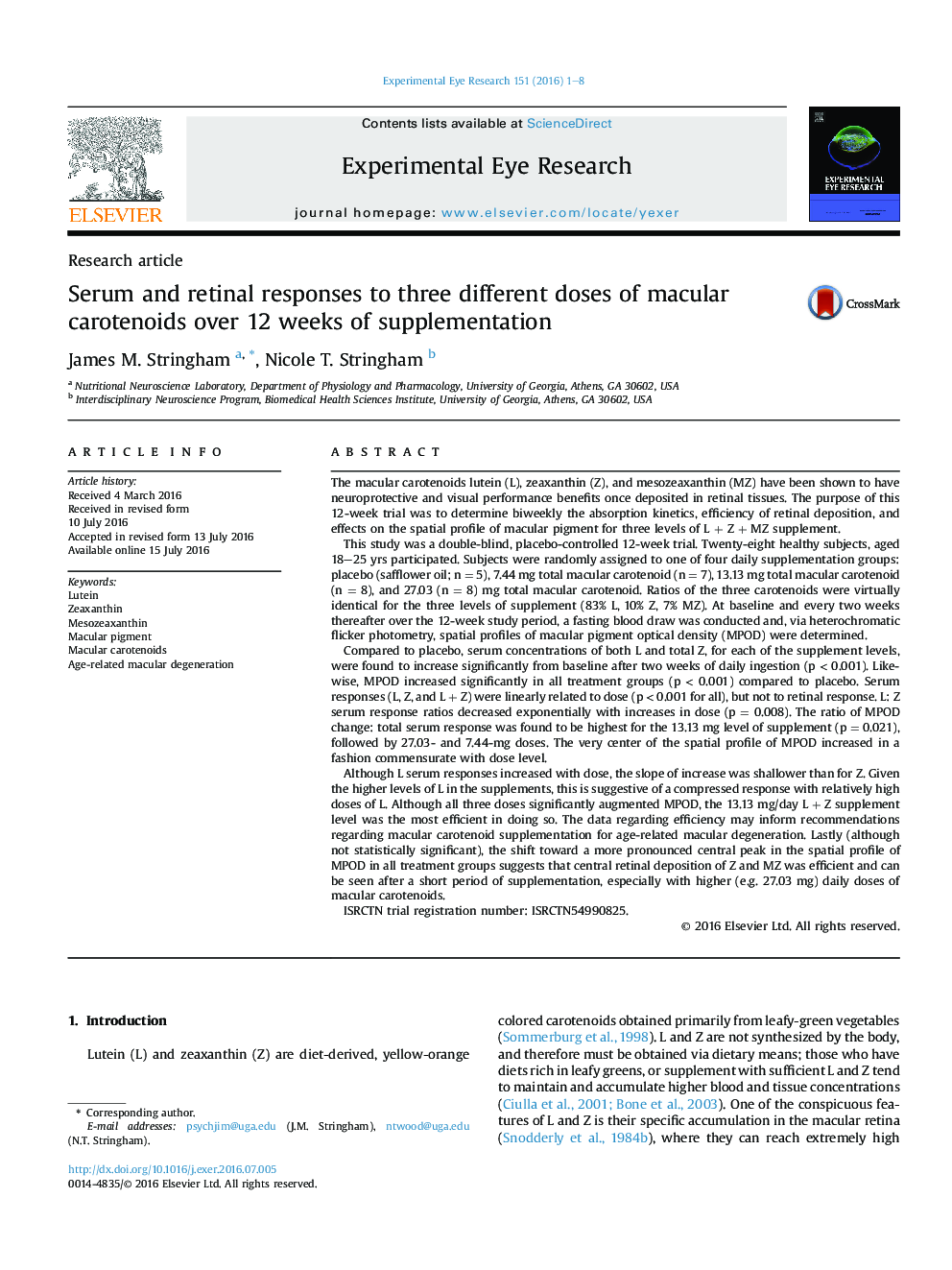| کد مقاله | کد نشریه | سال انتشار | مقاله انگلیسی | نسخه تمام متن |
|---|---|---|---|---|
| 6196175 | 1602571 | 2016 | 8 صفحه PDF | دانلود رایگان |
- This study determined the absorption kinetics and efficiency of retinal deposition for three levels of macular carotenoid supplement.
- Both serum carotenoid concentration and macular pigment optical density increased significantly in all three treatment groups.
- Serum response was linearly related to dose, but not to retinal response.
- Lutein: zeaxanthin serum response ratios decreased exponentially with increases in dose.
- The most efficient total dose (retinal response: dose) for augmenting macular pigment was found to be 13 mg.
- Commensurate with dose, the central peak of the macular pigment spatial profile exhibited a trend toward becoming more pronounced.
The macular carotenoids lutein (L), zeaxanthin (Z), and mesozeaxanthin (MZ) have been shown to have neuroprotective and visual performance benefits once deposited in retinal tissues. The purpose of this 12-week trial was to determine biweekly the absorption kinetics, efficiency of retinal deposition, and effects on the spatial profile of macular pigment for three levels of L + Z + MZ supplement.This study was a double-blind, placebo-controlled 12-week trial. Twenty-eight healthy subjects, aged 18-25 yrs participated. Subjects were randomly assigned to one of four daily supplementation groups: placebo (safflower oil; n = 5), 7.44 mg total macular carotenoid (n = 7), 13.13 mg total macular carotenoid (n = 8), and 27.03 (n = 8) mg total macular carotenoid. Ratios of the three carotenoids were virtually identical for the three levels of supplement (83% L, 10% Z, 7% MZ). At baseline and every two weeks thereafter over the 12-week study period, a fasting blood draw was conducted and, via heterochromatic flicker photometry, spatial profiles of macular pigment optical density (MPOD) were determined.Compared to placebo, serum concentrations of both L and total Z, for each of the supplement levels, were found to increase significantly from baseline after two weeks of daily ingestion (p < 0.001). Likewise, MPOD increased significantly in all treatment groups (p < 0.001) compared to placebo. Serum responses (L, Z, and L + Z) were linearly related to dose (p < 0.001 for all), but not to retinal response. L: Z serum response ratios decreased exponentially with increases in dose (p = 0.008). The ratio of MPOD change: total serum response was found to be highest for the 13.13 mg level of supplement (p = 0.021), followed by 27.03- and 7.44-mg doses. The very center of the spatial profile of MPOD increased in a fashion commensurate with dose level.Although L serum responses increased with dose, the slope of increase was shallower than for Z. Given the higher levels of L in the supplements, this is suggestive of a compressed response with relatively high doses of L. Although all three doses significantly augmented MPOD, the 13.13 mg/day L + Z supplement level was the most efficient in doing so. The data regarding efficiency may inform recommendations regarding macular carotenoid supplementation for age-related macular degeneration. Lastly (although not statistically significant), the shift toward a more pronounced central peak in the spatial profile of MPOD in all treatment groups suggests that central retinal deposition of Z and MZ was efficient and can be seen after a short period of supplementation, especially with higher (e.g. 27.03 mg) daily doses of macular carotenoids.ISRCTN trial registration number: ISRCTN54990825.
Journal: Experimental Eye Research - Volume 151, October 2016, Pages 1-8
